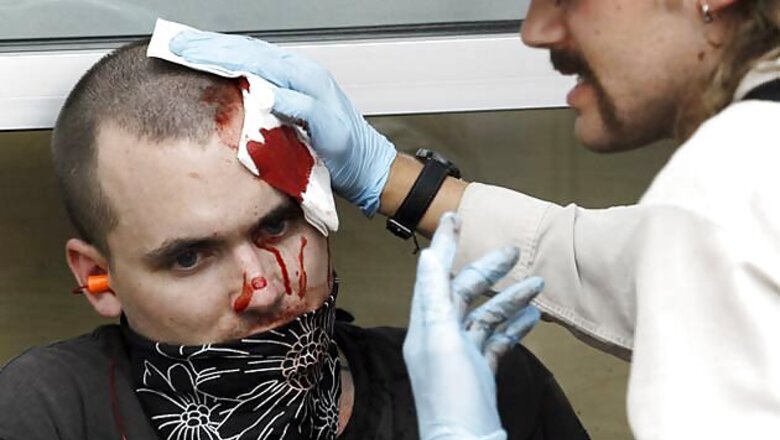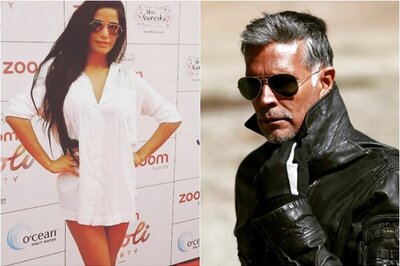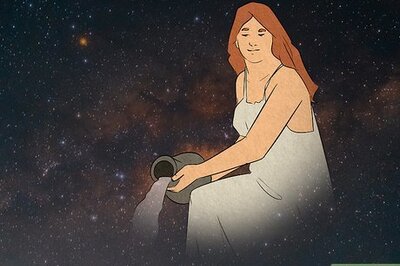
views
Chicago: Thousands of protesters marched through downtown Chicago on Sunday in one of the city's largest demonstrations in years, airing grievances about war, climate change and a wide range of other complaints as world leaders assembled for a NATO summit.
The protest, which for months had stirred worries about violence in the streets, drew together a broad assortment of participants, including peace activists joining with war veterans and people more focused on economic inequality. But the diversity of opinions also sowed doubts about whether there were too many messages to be effective.
And some of the most enduring images of the event were likely to be from the end - when a small group of demonstrators clashed with a line of police who tried to keep them from the lakeside convention center where President Barack Obama was hosting the gathering.
The protesters tried to move east toward McCormick Place, with some hurling sticks and bottles at police. Officers responded by swinging their batons. The two sides were locked in a standoff for nearly two hours, with police blocking the protesters' path and the crowd refusing to leave. Some protesters had blood streaming down their faces.
Authorities were seen making arrests one by one and leading individual demonstrators away in handcuffs.
After the clash near McCormick Place, Chicago Police Superintendent Garry McCarthy said at a news conference that the protests of the NATO Summit resulted in 45 people being arrested and four officers suffering injuries - one from a stab wound in the leg. Those numbers seemed certain to rise as new clashes erupted later in the night.
Esther Westlake, a recent graduate of Northeastern Illinois University, marveled at the size of the crowd. She said she had been involved in marches protesting the Iraq War in Chicago but never one this big.
"It's crazy. There's so many people here," she said. "Having NATO in town is kind of exciting."
But she wondered whether the political agendas of the protesters were too unfocused to get diplomats' attention.
"It seems like there's so many messages and people aren't really sure what they want to get accomplished," Westlake said. "People just need to figure out what their argument is going to be."
She worried that some protesters participated simply "to do stupid things" and cause trouble.
Some participants called for the dissolution of NATO, the 63-year-old military alliance that is holding its 25th formal meeting in Chicago. It is the first time the summit has been held in a US city other than Washington.
Diplomats at the meeting planned to discuss the war in Afghanistan, European missile defense and other international security matters.
"Basically NATO is used to keep the poor poor and the rich rich," said John Schraufnagel, who traveled from Minneapolis to Chicago for the march. Since the end of the Cold War, he said, the alliance has become "the enforcement arm of the ruling 1 percent, of the capitalist 1 percent."
The march lacked the size and single message that shaped the last major protest moment in Chicago, when nearly half a million people filled the city's downtown in 2006 to protest making it a felony to be an illegal immigrant.
At one point, dozens of protesters in black clothing surged toward a much smaller group of police, throwing objects at them. The badly outnumbered officers fought back with truncheons, and people on both sides threw punches. As police reinforcements moved in, the pack of violent protesters fled.
Authorities had planned to provide heightened security along the march route to protect people and property.
But unseasonably warm temperatures raised concerns about the safety of the marchers themselves. The city provided water, rest stations and cooling buses along the 2 1/2-mile protest route.
The heat offered an unexpected benefit for police: making it easier to spot potential troublemakers.
Before the summit, officers were told to keep an eye out for people wearing bulky clothing that could hide weapons or big pieces of cardboard that protesters could use to shield themselves against rubber bullets. But anyone wearing overcoats or sweat shirts was conspicuous on a 90-degree day, when many people wore T-shirts and shorts.
Organizers of Sunday's rally had initially predicted tens of thousands of protesters this weekend. But that was when the G-8 summit of leading industrial nations was also scheduled to be in Chicago. Earlier this year, President Barack Obama moved the Group of Eight economic meeting to Camp David, the secluded retreat in rural Maryland.
Chicago kept the NATO summit, which is not addressing the economy specifically. That left activists with the challenge of persuading groups as diverse as teachers, nurses and union laborers to show up for the Chicago protests even though the summit's main focus doesn't align with their most heart-felt issues.
At the end of the march, police appeared to be using precisely the tactics Superintendent Garry McCarthy said they would - extracting individuals from the crowd and quickly getting them away from the rest of the demonstrators.
Several times they could be seen pulling protesters into a line of officers, which parted briefly before quickly closing ranks again.
Police also used "sound cannons" to give orders to demonstrators and tried to relieve officers who had become fatigued to help prevent any escalation in violence.
The demonstrations unfolded just a day after three activists who traveled to Chicago for the summit were accused of manufacturing Molotov cocktails in a plot to attack Obama's campaign headquarters, Emanuel's home and other targets.
Defense lawyers argued that the police had trumped up the charges to frighten away peaceful protesters. They told a judge it was undercover officers who brought the firebombs to an apartment on Chicago's South Side where the men were arrested.
On Sunday, police said two other men were also in custody on charges they discussed making bombs prior to the summit. Authorities said the pair was not connected to the earlier arrests, although defense attorneys said all five were targeted by authorities to scare protesters away from the meeting.
####The demonstration


















Comments
0 comment